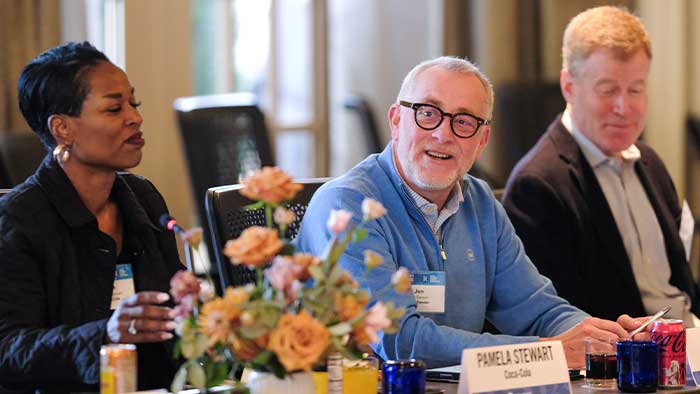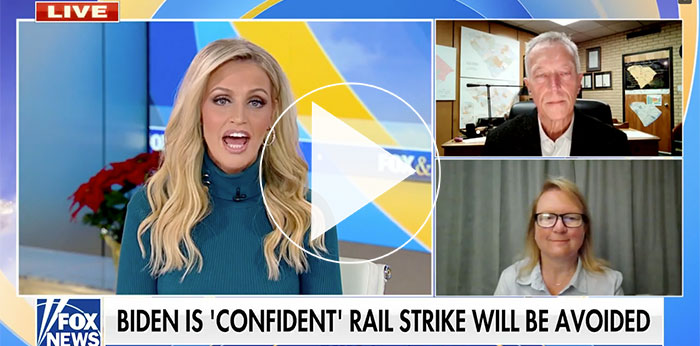- Home
- Focus Areas
- Supply Chain
- Navigating Retail Supply Chain Challenges
This year retail supply chains were under tremendous strain due to enormous demand, soaring costs to ship freight, constrained capacity and equipment shortages, systemic challenges of exiting transportation networks, and bottlenecks at ports.
Retailers have worked year-round to overcome these challenges, but unfortunately a new challenge is on the horizon.
RAIL STRIKE
The United States is facing the rising likelihood of a crippling national freight rail strike on December 9. The nation's freight rail companies and certain unions have not ratified a new contract after three years of negotiations. Roughly 40 percent of freight moves by rail in the U.S.(AAR facts & figures). The Association of American Railroads (AAR) estimates that a rail strike would cost the country $2 billion a day in lost economic output. The American Chemistry Council (ACC) recently said a prolonged strike would cost 700K jobs and add 4 points to the Producer Price Index (ACC Transportation & Infrastructure). Even the potential for a rail strike would create greater inflationary pressure, disrupt supply chains and harm retailers and consumers.
How did we get here?
The rail contracts expired in late 2019 and after 3-years of negotiations and mediation neither the railway companies nor the rail unions could come to an agreement. Under the Railway Labor Act (RLA) of 1926, President Biden acted by appointing three arbitrators to an emergency board to recommend a path forward. The recommendations were released on August 16, 2022. They cover over 115,000 employees of six major railroads and many smaller ones. With White House involvement, leadership of the two sides reached a tentative agreement on September 15, averting a strike that could have begun the following day. However, the tentative agreement required ratification by the unions’ rank and file members before it could be finalized.
A Shutdown Timeline
In accordance with federal safety measures, railroad carriers will begin preparing seven days before a strike by securing and prioritizing the movement of security-sensitive materials like chlorine for drinking water and hazardous materials in the rail winddown. Timeline: See a breakdown of the impact of a shutdown starting at 7 days out.
What's Next?
With the strike deadline approaching and no deal within sight, Congress needs to swiftly pass legislation codifying the Tentative Agreements reached in September.
Retailers: Congress Must Act to Avoid Rail Strike- reach a new agreement voluntarily or lawmakers and the White House do nothing, letting workers go on strike just before Christmas.
- legislation to extend the current cooling-off period
- implement the terms of an unratified agreement
- implement the recommendations of Presidential Emergency Board (PEB) No. 250
- impose other conditions on the parties.
Congress has intervened on several occasions to respond to rail disputes that were not resolved under the RLA’s procedures. The last time U.S. railroads went on strike was in 1992. That strike lasted just two days before Congress intervened. While the preferred option is for unions and freight rail companies to come to an agreement voluntarily, absent an agreement Congress should swiftly codify the White House-endorsed agreement reached in September and ensure America’s railways stay open for business.
LINK 2023
The Retail Supply Chain Conference gathers top executives in retail to network and learn. Experience expert-led education and a bustling Expo Experience.
Retail Supply Chain ConferenceIn the News
Our supply chain priorities include:
- Invest & Modernize Transportation Infrastructure: Leverage the input of major infrastructure users, including leading retailers, to help target investment from the bipartisan infrastructure deal for maximum impact.
- Strengthen Oversight of Ocean Shipping Industry: The Administration and Congress must bolster the Federal Maritime Commission’s work providing oversight of foreign-owned ocean carriers, carrier alliances, and terminal operators—sending the message that fair and open supply chains are essential to U.S. businesses and the American economy.
- Fortify Supply Chain Data Infrastructure: Consistent data and metrics, along with interoperable data standards, are essential to enable the reliability and end-to-end visibility required by today’s light-speed supply chains.
- Remove Barriers to Trucking: To restore capacity, the trucking industry needs over 80,000 drivers, and government policies must enable a pipeline of new drivers, as well as more efficient goods movement from reevaluating size & weight restrictions.
We continue to work together with our retail members, policymakers, and supply chain stakeholders to help the industry navigate these significant challenges and meet the needs of families and communities.
We can ill afford any sort of further disruption in supply chains or in the economy generally.

Jess Dankert
- Vice President, Supply Chain
- RILA
- Washington, DC
Latest Supply Chain Insights

Americans Cannot Afford Another Round of Price Increases
- By [Michael Hanson]
- 04/02/2025
Many products hit by more than one tariff
- 03/14/2025

Welcome to the Retail Supply Chain Innovation Flywheel!
- By [Jeff Ashcroft]
- 02/26/2025
Retail Litigation Center Announce Leadership Transition Plan
- 01/29/2025

RILA BOD Adds Four Leaders, Re-Elects Best Buy CEO as Chair
- By [Brian Dodge]
- 01/27/2025
RILA LINK Preview: Top Trends for 2025 are True Gamechangers
- By [Jeff Ashcroft]
- 01/17/2025


